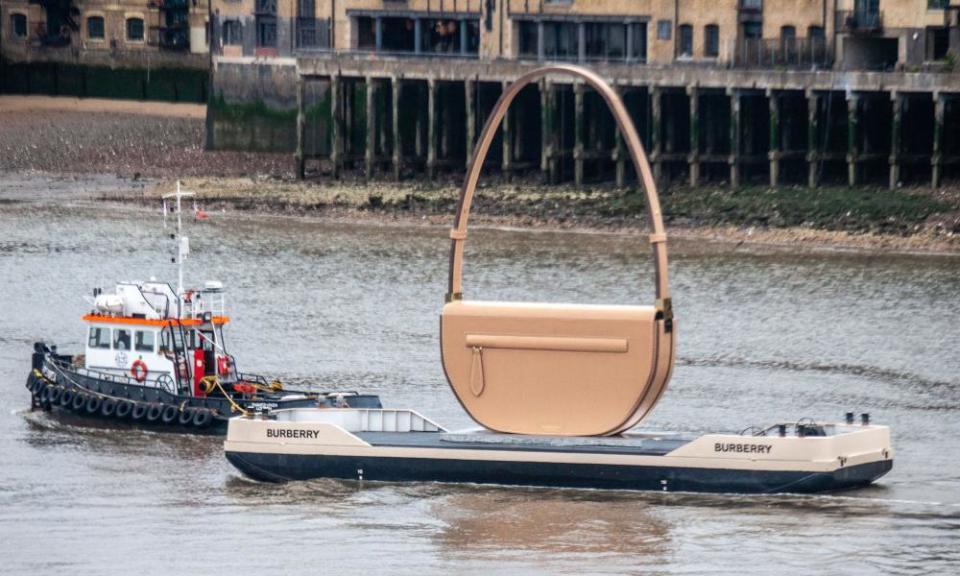Burberry sales return to pre-pandemic levels as younger shoppers splash out

The luxury fashion retailer Burberry has reported a rebound in sales to pre-pandemic levels driven by a boom in younger shoppers, with products including leather goods, jackets and shoes proving particularly popular.
Burberry, which operates 454 stores, concessions and franchises globally, said it had made an “excellent start to the year”, and the recovery had allowed it to stop the discount price strategy employed in stores and online globally during the coronavirus crisis to try to drive sales.
Related: Burberry’s change of leader should not mean a whole new wardrobe
The luxury fashion brand reported revenues of £479m in the 13 weeks to 26 June, up 86% on the same period last year, and 1% on sales in 2019.
“Full-price sales accelerated as our collections and campaigns attracted new, younger luxury customers to the brand,” said Marco Gobbetti, who announced last month he would stand down as chief executive after almost five years.
“We have made an excellent start to the fiscal year,” said Gobbetti, who is to become chief executive at the luxury Italian group Salvatore Ferragamo. “Despite the continuing challenging external environment, we are very pleased with the progress against our strategy.”
Gobbetti’s departure has prompted speculation he will be followed out of the door by Burberry’s creative head, Riccardo Tisci, who Gobbetti brought to the British brand having previously hired him at the luxury brand Givenchy.
Julie Brown, the finance director of Burberry, said the company was “very, very confident of Ricardo’s position”. She said Tisci “remains very excited by the opportunity to continue to inspire our customers with his imprint on Burberry’s identity, reinforced by the response to his latest collection”.
Tisci’s creations helped spur strong growth in key categories including leather goods and outerwear for Burberry over the quarter while it was able to scale back discounting online and in its main stores.
Social media activity, featuring celebrities such as the footballer Marcus Rashford, the singer FKA Twiggs and the model Kendall Jenner have also helped draw in younger shoppers despite restrictions on international travel which have hit tourist sales.
Burberry said sales of goods at full price were up 121% compared with last year, and up 26% compared with 2019. Full-price sales online more than doubled compared with pre-pandemic.
Full-price sales of leather goods and outerwear such as jackets, quilts and downs doubled compared with last year, while there was triple-digit growth for shoe sales year on year.
Sales levels grew 146% year on year in Europe, the Middle East, India and Africa (EMEIA), 27% in Asia Pacific and 341% in the Americas.
The Americas region rose to pre-pandemic sales levels, up 34%. Sales in Asia Pacific have returned to pre-pandemic levels, up 7% compared with 2019, driven by a boom in new shoppers in mainland China, which were 55% higher than pre-pandemic, and in Korea, where they rose more than 90%.
However, sales in the EMEIA region remain 38% below pre-pandemic levels as the region continues to be hit by low levels of tourists and store closures because of Covid-19, particularly in continental Europe.
Burberry shares were down 4% in afternoon trading on Friday, making it the biggest faller on the FTSE 100.
On average, 11% of Burberry’s stores were closed during the trading period, although this reduced to only 3% by the end of June as pandemic restrictions continue to be eased in most markets. However, more than a third of stores are still operating on reduced hours.
Susannah Streeter, senior investment and markets analyst, Hargreaves Lansdown, said Europe remained a “weak spot” for the brand as Covid restrictions affected trade.
“When the company is firing on all cylinders once more, there is good potential for growth across all channels. However, with new variants still disrupting economies around the world, there is still uncertainty ahead,” she said.
“A big obstacle waiting to trip up the company on this catwalk of recovery is the departure of CEO Marco Gobbetti. He has been seen as the turnaround tsar for Burberry and investors are questioning the company’s ability to keep driving through the strategic turnaround without him in the front row.”